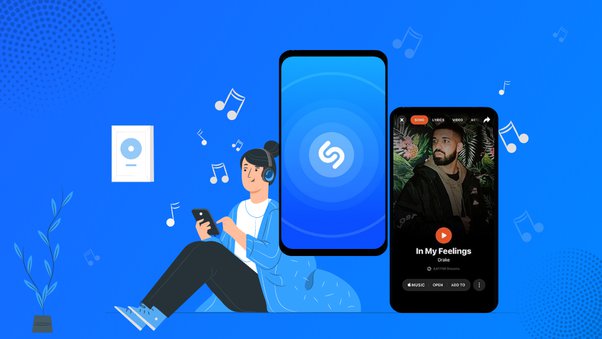Have you ever been in a cafe or clothing store and heard a catchy song playing, but didn’t know the name or artist? With Shazam, you can instantly identify songs just by holding your phone up to the music. But how does it work so fast? In this post, we’ll break down the audio fingerprinting algorithm behind Shazam and other music recognition apps.
Shazam is one of the most popular song identification apps, with over 1 billion downloads on the App Store. The core technology behind Shazam’s magic is called audio fingerprinting. It allows the app to pick out unique characteristics of a song and match it against a database of millions of tracks in a matter of seconds.
This algorithm enables Shazam to find song matches even in noisy environments. You could be at a crowded party or blaring music in your car, and Shazam can still recognize the song playing. Read on to learn exactly how this clever technology achieves such fast and accurate music detection.
How Audio Fingerprinting Works
Audio fingerprinting refers to techniques for creating a unique digital “fingerprint” to identify an audio sample. Here are the key steps involved:
- Step 1: Convert the audio track to a spectrogram. A spectrogram is a visual representation of the audio frequencies in a song over time. Shazam analyzes about 10-15 seconds of audio to create a detailed spectrogram.
- Step 2: Identify key points for fingerprinting. The algorithm picks out peaks of high energy and other identifiable points in the spectrogram to use as landmarks. These form the core of the audio fingerprint.
- Step 3: Create a digital hash. A hashing function converts the key points into a compact digital code or hash. Even small changes in the audio will result in a very different hash.
- Step 4: Match against a song database. Shazam has an extensive pre-processed database of song fingerprints. It searches this database to find an identical or very close hash match, revealing the song identity.
Why Audio Fingerprinting is So Powerful
Audio fingerprinting gives Shazam speed and accuracy advantages over other techniques:
- Works in high noise environments: The algorithm focuses on energy peaks that stand out even with background noise.
- Faster than analyzing full audio: Hashing landmark points makes matching much quicker than analyzing the full spectrogram.
- Matches acapella or re-recorded versions: The fingerprints encode the essence of a song, ignoring specific instruments, keys, tempos etc.
- Compact storage of millions of fingerprints: Hashes are typically just a few hundred bytes per song, enabling a huge server-side database.
- Hard to trick with spoof audio: Even slightly modified audio will result in entirely different fingerprints, making spoofing difficult.
Shazam’s Audio Fingerprinting Process Step-By-Step
Now let’s walk through Shazam’s song matching process in more detail:
- You tap the Shazam button to initiate a song match.
- The app begins recording 10-15 seconds of audio through your phone’s mic.
- The recorded audio is converted into a detailed spectrogram.
- The algorithm analyzes the spectrogram to pick out identifiable landmark points. These form the core “fingerprint”.
- A hashing function calculates a compact hash code or fingerprint from these landmarks.
- Shazam transmits the fingerprint to its servers for matching against the song database.
- If there is a match, the song information is sent back to your phone, often taking less than 5 seconds!
- You see the song title, artist, album artwork, and other metadata on your phone.
- The song is saved to your Shazam history and added to Spotify playlists if you choose.
And that’s how Shazam magically recognizes music! The audio fingerprinting algorithm is quick, robust, and efficient – ideal for identifying songs in real-world environments. This technology continues to improve as Shazam expands its music database and fingerprinting techniques.
Frequently Asked Questions (FAQ’s)
How large is Shazam’s song database?
Shazam’s database contains over 20 million song fingerprints and is continually growing. This vast library covers popular new releases as well as older, more obscure tracks.
What if a song isn’t in Shazam’s database?
You can use Shazam to send a new song fingerprint to its servers for analysis. If enough users request an unrecognized track, it will be added to the database.
Does audio quality affect Shazam’s accuracy?
Shazam is designed to work even with degraded audio quality. However, very low bitrate files can potentially impact fingerprint accuracy. Performance is best with music from online streaming services.
Can Shazam identify live concert recordings?
Yes, as long as the audio quality is reasonable. The algorithm can match live versions to studio recordings, as it focuses on the underlying song structure.
Does Shazam work on singing or humming?
Unfortunately Shazam cannot recognize singing or humming like SoundHound. It relies on a full instrumentation fingerprint for accurate matching.
Conclusion
Shazam’s massively popular song recognition would not be possible without the power of audio fingerprinting. This technology allows the app to pick out defining features of a song to create unique fingerprints, and rapidly match them against a huge database. Audio fingerprinting provides speed, robustness, and compact storage of millions of fingerprints. Next time you want to identify a song, just launch Shazam and see this clever algorithm in action!
